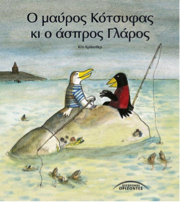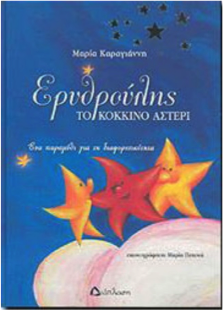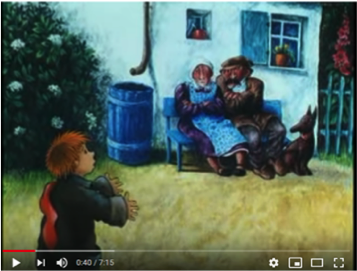The Black Mockingbird and the White Gull, Little Reddy the red star, and "Irini" (Peace) - The story of a refugee child (age range: 6-7)
Main Criteria:
• Participative activities
• Active engagement of all participants/ decision making
• Critical reflection/ recognition problem solving
• Focus on multiculturalism and intercultural education values
• Family engagement
AIms:
• To identify / understand feelings and be able to manage them
• To develop empathy and a critical attitude
• To recognize and respect diversity
• To develop strategies to tackle racism
• To become aware that we all need to be active citizens and seek justice and peace in the world
• To become familiar with the concepts of justice, solidarity and mutual benefit
• To be actively involved in decision making
LINKS TO CURRICULUM:
Literacy in the language(s) of instruction.
PROCEDURE:
Sub-Activity 1: The Black Mockingbird and the White Gull'

few words about the story: "Why is everybody looking at me strangely?" asked Jacobs, the mocking bird. " But it is the first time they have seen a black bird like you," said Jimmy, the seagull. In the village of the white gulls, the black mocking bird is a stranger, no one wants him. By the time they find out how great this weird stranger is ... A fascinating story for preschool children and young readers, referring to real friendship, xenophobia, racism.
How will the gulls behave towards the 'stranger'?
What problems will it face?
What is the role of true friendship?
How do the seagulls react when they meet the mocking bird? Why?
How do you think Jacob feels like ?
How does his friendship with Jimmy help him?
Finally, how do they accept Jacob and why?
Who could be the mocking bird in real life?
What is the role of true friendship?
Sub-Activity 2: Little Reddy the red star

A few words about the story: Little Reddy is the only red star among the thousands of gold stars in the sky. However, what is different is often not immediately accepted even in the star world. How will Little Reddy react to the rejection he receives and how will he ultimately manage to integrate into the group of stars.
How will Little Reddy react to the rejection:
What will his feelings be?
Finally can the different one survive?
What makes Little Reddy different?
How does he experience rejection?
How does he react?
Will he ultimately be able to join the group of stars?
What would you advise him to do?
Sub-activity 3: "Irini" (Peace) - The story of a refugee child

The story refers to a young girl who is forced to leave her home, to experience insecurity and rejection until she finds warmth, protection and affection in a new home.
Who are the heroes/heroines of the story?
Where do you think this story takes place?
What do you think happened and made Irini (Peace) leave alone?
The students are encouraged to express their opinions, experiences and thoughts. They discuss, ask questions.
They bring their own experiences into contact with people with different languages, their origin, sex, etc. They are encouraged to observe, talk, paint, imitate, disguise and use their imagination, based on the figures in the booklet, the books and the animated film.
The students develop empathy for the heroes/heroines of stories. They express questions, thoughts and concerns and are encouraged to suggest solutions and express their own views on what needs to be done: "not to discriminate against the other", "to respect diversity", "to develop the concept of social- personal responsibility".
They form their own worldview about how our world can be better and are involved in a process of reflection and decision making for this purpose.
They put themselves into the other's shoes through role-plays.
EXPERIENCE IN STEPS
• Students are divided into pairs and look for three differences and three similarities
• They paint them
• The children recognize diversity and conceptualize it as variety in appearance, preferences, etc
• Based on the readings of the books and the film we create a collage (eg the collage of friendship, love)
• We write on craft paper words selected by the students in different languages, emphasizing their home languages as well.
They learn and play with these words in different languages.
• Based on the story of Irini (Peace), they draw scenes of story and re-narrate it.
• They understand the feelings of the heroes/heroines of each story and portray them with their own paintings in a different language.
• They do role playing and recognize the feelings of others.
• After the questions on the story elements (How did the persons of the story behave towards Irini (Peace)?…How did the Good-hearted begave?…Why did they call him like that?..) the children are led to the recognition that the story may look like a fairy tale but through the question .. could it be true ... and so they find it out ...
• A discussion follows about the racist attitudes which the refugee girl was faced with and the concept of racism is clarified (is she inferior due to origin, religion, is she foreign or just different?) ... what makes us racists ... the consequences ... how we fight it... what we can do... write a poem ... let's read this first.
• We read the poem by G. Ritsos "A Prayer"
Κάνε, καλέ Θεούλη, εμείς `μαστε καλά.
Κάνε, καλέ Θεούλη να `χουν όλα τα παιδάκια
ένα ποταμάκι γάλα,
να `χουν μπόλικα τραγούδια, αστεράκια
Κάνε να είναι όλοι καλά
Κάνε να έχουν όλα τα παιδιά
να μην ντρεπόμαστε για τη χαρά μας
"May, dear God, we all be well
May , dear God, all children have
a stream of milk,
have a lot of songs, little stars
May everyone be well
May all children have
let us not be ashamed of our joy"
We give the beginning:
"Dear God, we are well
May, dear God
all children have.."
And they continue ... writing their own poems
• They create drawing poems with a pigeon of Peace
• They create a poster entitled …"When Love Comes" where they draw beautiful acts of love and write messages - words (love, friendship, respect, support, help, acceptance ...).
• They write the recipe for volunteering or love with ingredients and procedure.
• They write the Alphabet of offering
• They create their own "It's OK" (e.g. It's OK to be from Greece ... it's OK to be from another country ..)
• Games for Empathy :
"Silent Greetings"
The children walk around and exchange greetings, without talking, with a smile, with a small hand waving, with head movement, by looking at each other or moving their hand ... accompanied by music from different cultures.
"Show Me How You Feel"
The children are in a circle. They come one by one to the center and show with movement how they feel today, and then they say their name in a way that reveals their emotion without specifying it. The others interpret.
«Mirroring»
The children are in couples. One imitates the movement of the other, as if in a mirror, as closely as possible.
«I Walk Like You»
The leader walks as a giant, elderly, trained, tired, etc. and the others imitate him. The leader rings a bell and everyone freezes up. Someone else takes over as leader
Multimodal (TECHNOLOGICAL SUPPORT AND OTHER SUPPORT)
• Video projector, maps, pictures
• Educational approaches using ICT
• Using ICT, they search (on the internet) the benefits of bilingualism, and relevant definitions. They listen to other languages on the internet, translate words or phrases with the help of the class teacher or their family
Further development
We invite parents who have come other countries to tell us about their experiences.
They talk about their culture and culture.
We locate the place of origin of each child on the map.
Links to curriculum
Social and Environmental Studies, Social Education, Art, Language
Materials and digital tools
http://collections.internetmemory.org/unhcr/20171002021437/http://www.unhcr.gr/ekpaideysi/ekpaideytiko-yliko/eirini.html
http://collections.internetmemory.org/unhcr/20171002021437/http://www.unhcr.gr/fileadmin/Greece/Extras/education_symbiosis/Symbiosis_project_manual_final.pdf
https://www.youtube.com/watch?v=KfoN2pSn2nU